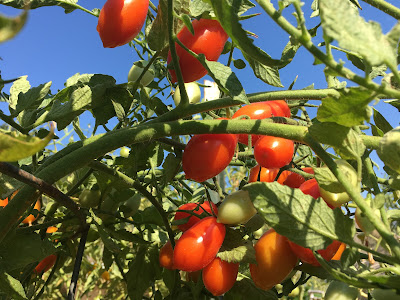
'Totally Tomatoes' online with Placer County master gardeners

|
|
Hoping for lush crop of tomatoes this year? The
"Totally Tomatoes" workshop will be full of tips for
the home gardener. (Photo: Kathy Morrison)
|
If growing a perfect tomato seems like an unachievable goal -- even in an area known for its tomatoes -- then the Placer County master gardeners have the perfect class at the perfect time of year.
"Totally Tomatoes" will be offered free online via Zoom, 10:30 to 11:30 a.m. Saturday, Feb. 26.
"Learn about planting, growing, and caring for this delicious staple as well as how to control problems before they happen," the master gardeners say. "Let us help you grow the ultimate tomato -- firm and juicy, sweet and tangy."
The Zoom link is here: https://us02web.zoom.us/j/81516329742 and the passcode is: garden.
The Placer master gardeners also have two Zoom workshops coming up in March: "Dealing With Deer" on March 12 and "Planning Your Vegetable Garden" on March 26. Each starts at 10:30 a.m.
Links to several of their past recorded workshops -- as well as handouts related to the presentations -- can be found here: https://ucanr.edu/sites/ucmgplacer/files/363166.pdf
For general information on Placer County master gardener activities and resources, go to https://pcmg.ucanr.org/
-- Kathy Morrison
Comments
0 comments have been posted.Sacramento Digs Gardening to your inbox.
Sites We Like
Garden Checklist for week of July 21
Your garden needs you!
* Keep your vegetable garden watered, mulched and weeded. Water before 8 a.m. to reduce the chance of fungal infection and to conserve moisture.
* Feed vegetable plants bone meal, rock phosphate or other fertilizers high in phosphate to stimulate more blooms and fruiting. (But wait until daily high temperatures drop out of the 100s.)
* Don’t let tomatoes wilt or dry out completely. Give tomatoes a deep watering two to three times a week.
* Harvest vegetables promptly to encourage plants to produce more. Squash especially tends to grow rapidly in hot weather. Keep an eye on zucchini.
* Pinch back chrysanthemums for bushy plants and more flowers in September.
* Remove spent flowers from roses, daylilies and other bloomers as they finish flowering.
* Pinch off blooms from basil so the plant will grow more leaves.
* Cut back lavender after flowering to promote a second bloom.
* It's not too late to add a splash of color. Plant petunias, snapdragons, zinnias and marigolds.
* From seed, plant corn, pumpkins, radishes, winter squash and sunflowers.